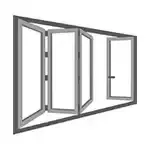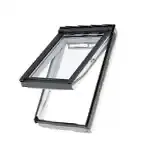
Navigating Tariff Challenges with Best Aluminum Doors from China for Global Buyers
In the complex landscape of international trade, navigating tariff challenges has become a critical concern for global buyers, particularly in light of the ongoing trade tensions between the United States and China. This situation has prompted manufacturers to rethink their strategies and adapt to new economic realities. Among the standout products that continue to thrive in this environment are China's best aluminum doors, renowned for their durability, aesthetic appeal, and versatility. Despite the imposition of reciprocal tariffs, the aluminum door industry in China has demonstrated resilience and even experienced growth, as businesses seek high-quality solutions that meet international standards. By leveraging innovative designs and competitive pricing, these manufacturers are not only overcoming tariff obstacles but also catering to the evolving needs of global consumers. In this blog, we will explore how Chinese aluminum doors are successfully navigating the challenges posed by tariffs while maintaining their appeal in the global market.

Addressing Tariff Impact: Strategies for Global Buyers of Aluminum Doors
The aluminum door market has seen significant fluctuations due to rising tariffs, prompting global buyers to adopt strategic approaches to mitigate costs and secure quality products. According to a report by Grand View Research, the global market for aluminum doors is projected to reach USD 36.5 billion by 2025, driven by demand in residential and commercial sectors. However, increases in tariffs on imported aluminum from countries like China have raised concerns among buyers regarding pricing stability and supply chain disruptions.
To effectively navigate these tariff challenges, global buyers should consider diversifying their supplier base. Engaging with multiple manufacturers not only fosters competition but also helps in leveraging more favorable pricing structures. Additionally, buyers should prioritize suppliers that can provide transparent pricing models and insights into their production processes. A study from the U.S. International Trade Commission emphasizes that companies minimizing tariff exposure through local sourcing can see a reduction of up to 15% in overall procurement costs. By aligning procurement strategies with market realities, global buyers can better position themselves to thrive despite the ongoing tariff pressures.
Navigating Tariff Challenges: Aluminum Door Imports and Tariff Rates
Understanding China's Resilient Manufacturing Amidst Tariff Hikes
In the landscape of global trade, tariff hikes pose significant challenges for buyers sourcing aluminum doors from China. However, China's resilient manufacturing sector has demonstrated remarkable adaptability in the face of these obstacles. By employing innovative strategies, Chinese manufacturers continue to provide quality products while navigating complex tariff structures, maintaining their competitive edge in the market.
When purchasing aluminum doors from China, global buyers should consider leveraging the following tips. First, establish strong relationships with suppliers who have a proven track record of overcoming tariff-related issues. This can ensure a smoother supply chain and advocate for your needs. Second, explore bulk purchasing options or local inventory to mitigate potential tariff impacts. By holding stock near your market, you can bypass some logistics-related costs associated with tariffs.
Moreover, always stay informed about trade policies and tariff changes that may affect your purchases. By staying ahead of potential shifts in trade regulations, you can strategize accordingly and engage in proactive sourcing. Understanding these dynamics will empower buyers to make informed decisions while benefiting from China's robust manufacturing capabilities.

Identifying Quality: Best Aluminum Doors to Source from China
When sourcing aluminum doors from China, quality is paramount. With numerous manufacturers in the market, identifying top-tier products can be daunting for global buyers. A good starting point is to prioritize door specifications, including insulation properties, aesthetics, and durability. High-quality aluminum doors should exhibit excellent weather resistance and minimal maintenance requirements, ensuring they stand the test of time while enhancing the visual appeal of any property.
Moreover, buyers should consider manufacturers that adhere to international quality standards, which often include certifications like ISO and CE. Engaging in factory audits or relying on trusted local agents can provide deeper insights into the production processes and material sourcing. Additionally, examining customer reviews and case studies can shed light on the reliability and performance of specific door models. By focusing on these aspects, global buyers can confidently navigate the complex landscape of aluminum door sourcing in China, ensuring they select only the best for their projects.
Navigating Tariff Challenges: An Overview of Aluminum Door Quality from China
This pie chart represents the different quality ratings of aluminum doors sourced from China based on a survey of global buyers. The data highlights the perceived quality levels, which can aid in making informed sourcing decisions while navigating tariff challenges.
Navigating Import Regulations: What Buyers Need to Know in 2023
In 2023, global buyers looking to import aluminum doors from China must navigate a complex landscape of import regulations. Each country has its own set of rules that govern the process, often influenced by tariff policies and trade agreements. Understanding the specific regulations in your region is crucial to avoid delays or additional costs. Buyers should familiarize themselves with necessary documentation, such as import permits, customs declarations, and compliance with safety standards to ensure a smooth transaction.
In addition to regulatory compliance, buyers must also be vigilant about the fluctuating tariffs imposed on foreign goods. These tariffs can significantly affect the final cost of aluminum doors, impacting your bottom line. It is advisable for buyers to stay updated on international trade policies and engage with customs brokers who can provide expert guidance. Establishing reliable communication with suppliers in China is also important to negotiate terms considering the potential tariff implications. By taking these proactive steps, buyers can make informed decisions and successfully navigate the intricacies of importing aluminum doors in today’s global market.
Future Trends: The Evolving Landscape of Aluminum Door Trade Between China and the U.S.
The landscape of aluminum door trade between China and the U.S. is undergoing significant transformation due to ongoing trade tensions and tariff challenges. Over the past few years, tariffs implemented by the U.S. government have led to a marked decline in trade volumes, with some reports indicating that imports of aluminum products from China have dropped by over 30% since the inception of these tariffs. The implications for global buyers are profound; increased costs associated with these tariffs force companies to rethink their sourcing strategies and potentially pivot towards domestic alternatives or other regions with more favorable trade conditions.
Moreover, as the Biden administration re-evaluates U.S. trade policies, there are questions surrounding the future trajectory of tariffs and their economic impact. Recent analyses suggest that a surge in innovation within China’s aluminum manufacturing sector may position Chinese manufacturers as more competitive despite the high tariffs. With China’s advancements in production technologies and efficiency, companies that adapt to these changes could find opportunities in sourcing high-quality aluminum doors that meet international standards. Observations from industry reports indicate that strategic partnerships with leading Chinese manufacturers that incorporate advanced technologies will be essential for global buyers to navigate these complexities effectively.





 Sliding Door
Sliding Door Folding Window
Folding Window Skylight
Skylight Casement Window
Casement Window Sliding Window
Sliding Window System Window
System Window Tilt and Turn Window
Tilt and Turn Window Sun Room
Sun Room